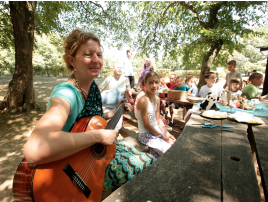Supreme Court Order Precedes Biggest March Yet for Yamuna River
By Madhava Smullen | Jan 17, 2013

Photography by Filip Cargonja.
Beginning with a Supreme Court order in New Delhi in November, recent developments show an escalation in the battle for India’s sacred Yamuna river—which was declared ‘dead’ by the Ecological Department of India.
For the past two years, devotees and environmentalists have tried to raise awareness of the fact that while the Yamuna emerges clean from Yamunotri, its source in the Himalayas, there is barely a drop of the original sacred river left by the time it reaches Vrindavana, where Lord Krishna is said to have once lived.
On Friday November 9th, 2012, the case finally reached the Supreme Court in New Delhi.
“The Yamuna is a drain,” the Central Pollution Control Board (CPCB) told the Court, “With not a drop of fresh water in its twenty-two kilometer stretch through Delhi.”
CPCB counsel Vijay Panjwani informed Justices Swatanter Kumar and S.J. Mukhopadhaya that all fresh water was held back at Delhi’s Wazirabad barrage to provide drinking water to Delhi residents.

The water in the hills, still crystal clear.
Next, a court-appointed expert body stated that for a major part of the year, the river ceases to exist downstream of Wazirabad barrage, and consists only of waste from the Najafgarh sewage drain.
Their interim report said that the drain discharges about 2,064 million litres per day of waste water into the Yamuna, 1,435 million of which remain completely untreated.
In response, the Supreme Court gave the expert body three weeks to present a plan for closing all drains into the sacred river, and asked its members to suggest remedial measures to clean up the Yamuna.

The ghat where 97% of the water is diverted.
While these developments are a heartening step in the right direction, Save the Yamuna campaigner Radha Jivan Das believes that the biggest change will come from a high level of public awareness and protest, pushing the government to take action to retain its popularity.
“That’s the way India runs,” he says. “The way to get anything done is to have a lot of people talking about it.”
And there’s no doubt that a lot of people are talking about it. Radha Jivan, an ISKCON devotee, has been helping the Vrindavan-based group Maan Mandir, headed by sadhu and environmentalist Ramesh Babaji, in steadily ramping up public awareness for the past year and a half.

What remains in the riverbed dries out completely within a few kilometers.
In April 2011, they had one thousand people march from Allahabhad, where the Yamuna meets the Ganges, to the common protest ground of Jantar Mantar in Delhi. There, the crowd grew to 20,000, and seventy-two people went on a six-day hunger strike.
The protest gained the support of Bhanu Pratap Singh and his 100,000-strong Bhartiya Kisan Farmer’s Union. Save the Yamuna campaign heads also got to meet with Sonia Gandhi, president of the Indian National Congress Party, and Water Minister Salman Khurshid.
On February 1st 2012, a one-year, 24-hour kirtan began at Vrindavana’s Keshi Ghat in protest of the Yamuna’s plight, with 1,000 villages participating. The kirtan continues to built publicity as it reaches its conclusion.

The fresh water gets replaced by untreated sewage and industrial waste.
More recently, national public service television channel Doordarshan ran a one-hour program, called “Ehsaas” or “Realization” about the key Yamuna river issues.
What’s expected to really push the tide, however, is Save The Yamuna’s biggest-ever march, to be held on March 1st this year.
The march, which will begin in Mathura, near Vrindavana, and culminate at the Ramlila Grounds in Delhi, is already drawing a huge amount of attention.
“There are people known as Bhagavat Acharyas, who are extremely popular Bhagavat Saptaha speakers,” says Radha Jivan. “They speak the Srimad-Bhagavatam to crowds of 50,000 people at one time, and are broadcast on television. One hundred of them came to see us, and said that they would cancel their Bhagavat Saptahas in the month of March, to join us in marching to Delhi.”

Pilgrims are not aware that what they bathe in is not the holy river anymore.
The Vallabha Acharyas—heads of the Vallabha Sampradaya, a Vaishnava line—are also in full support of the march. The group is currently holding a series of public awareness programs in major cities throughout Gujarat, which are attended by thousands of followers, and are expected to raise 25 Crores of rupees (5 million US dollars) to finance the march.
The money is needed to feed and care for the huge turnout expected at the march—an unbelievable half a million people. The first day of the event will shut down the towns of Vrindavana and Mathura, while the crowds will cause gridlock on National Highway 2, which runs through Vrindavana.

Vigil on the banks of the dead river Yamuna.
The event is expected to be huge news throughout the country, and will put much needed pressure on the government, which has been taking the campaign a little too lightly so far according to Radha Jivan.
“We think we probably won’t have to march all the way to Delhi,” he says. “The government will intervene and will come and try to negotiate something with us, maybe in a day or two, maximum three days of walking.”
“We want the government to recognize this campaign,” he concludes, “And give us a solid plan for what they’re going to do about the Yamuna river.”















